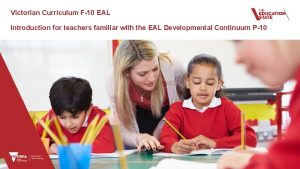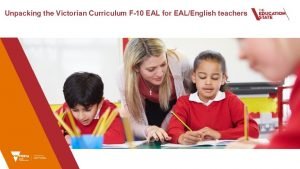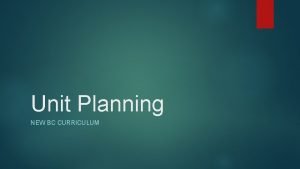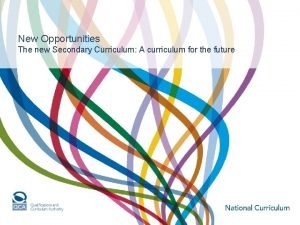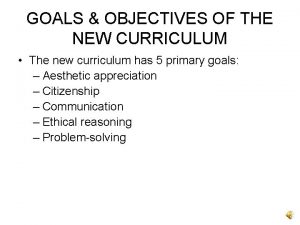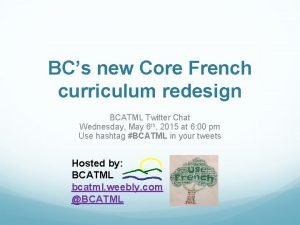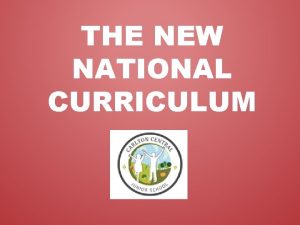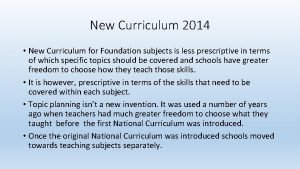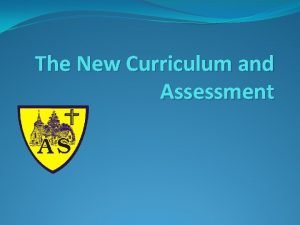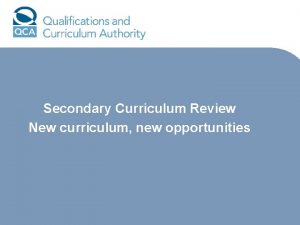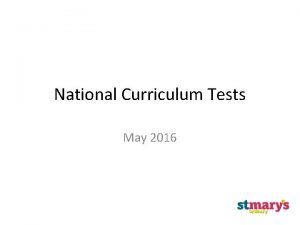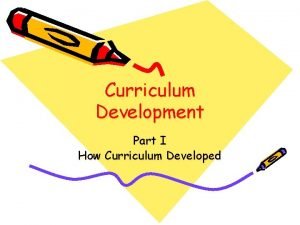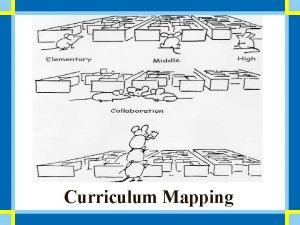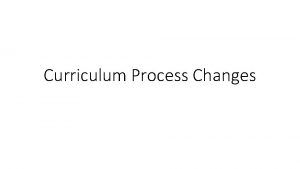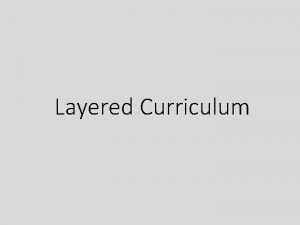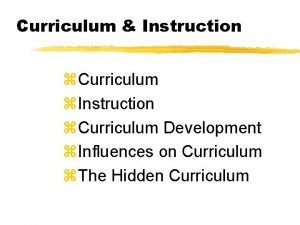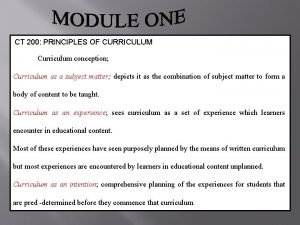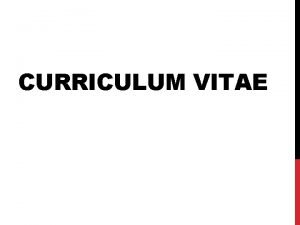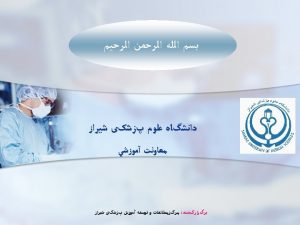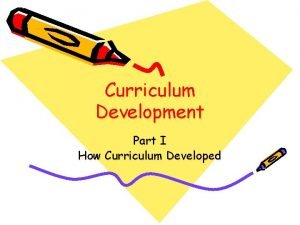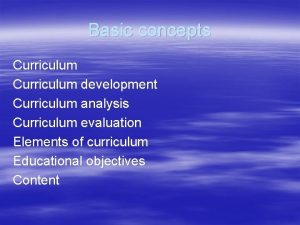The new National Curriculum The national curriculum is






























- Slides: 30

The new National Curriculum The national curriculum is a government document. It states what your child should learn in a range of subjects and when. This is the first year that the children will be assessed on the new curriculum.

What does the New Curriculum mean? A greater focus on core skills including widening and deepening understanding. More ambitious end of year expectations for every year group. Changes to what your children learn at school.

At the end of Year 2 your child will either be: Working towards the expected standard Working at greater depth within the expected standard

Children will be assessed and achievement will be reported in Reading Writing Mathematics 4

Reading in Year 2 A typical Year 2 child in reading is expected to: Read most words quickly and accurately, without sounding out. Show awareness of punctuation marks. Identify when reading does not make sense and quickly self-correct. Use clues from what they have already read to make predictions. Discuss reasons for events, using inference Why? When? How? Summarise a story giving the main parts in the correct order.

6

SATs - Reading There will be two reading papers; both contain 2 texts, one fiction and one nonfiction. Paper 1 Smaller sections of text and then questions. Paper 2 Longer section of text followed by questions.

What can I do at home to help develop my child’s reading skills? Listen to your child read at some point every day. Encourage your child to make predictions. Ask about characters’ feelings and talk about their actions. Discuss the meaning of words specific to the book that you think your child might be unsure of. Ask questions to ensure your child is understanding what they are reading. Can they retell the story?

Writing in Year 2 In their writing, a typical Year 2 child is expected to: Write simple sentences which are grammatically correct. Include some co-ordination and subordination, e. g. or, and, but, when, if, that, because. Use a range of punctuation accurately. Spell common exception words correctly. Use legible handwriting, including some joining. Self check their writing and make improvements. Above needs to be across fiction and non-fiction writing.

10

SATs - Grammar, Punctuation and Spelling (GPS) There will be two papers. Paper 1: Spelling. Task 1: Children write down the words that they hear. Task 2: Dictation – Children asked to follow and fill in the gaps. Paper 2: Grammar, Punctuation and Spelling. Questions presented in a range of formats. Focus on vocabulary.

What can I do at home to help develop my child’s writing skills? Encourage your child to write at home for a range of purposes. Model writing for your child, correct pencil hold and letter formation. Encourage correct spelling of common exception words. Talk about your child’s writing, e. g. How could we improve this? Use the correct grammar and punctuation terminology when reading with your child. Encourage your child to read through their writing when they have completed it and make any necessary corrections

Maths in Year 2 A typical Year 2 child in maths is expected to: Count in steps of 2, 3 and 5 from 0, and in tens from any number forwards and backwards. Recall and use multiplication and division facts for the 2, 5 and 10 multiplication tables. Add and subtract two 2 -digit numbers. Solve problems involving addition, subtraction, multiplication and division. Recognise, find, name and write fractions ½, 1/3, ¼, 2/4, ¾ of a length, shape, set of objects of quantity. Tell and write the time to fifteen minutes. Find different combinations of coins that equal the same amounts of money and recognise and use symbols for pounds (£) and pence (p).


15

16

SATs - Maths There are two maths papers. Paper 1: Mental arithmetic. Paper 2: Reasoning. The focus is on number fluency. The only equipment allowed is a pencil, ruler and an eraser.

What can I do at home to help develop my child’s maths skills? Count! Forwards and backwards in 1 s 2 s 5 s and 10 s. Practise number facts that should be secure; number bonds, addition facts, subtraction facts, doubles, halves and multiplication and division facts. Practise telling the time to the nearest 15 minutes. Practise counting amounts of money, go shopping together, pay and calculate change.

How do we make assessments? We are collecting evidence all day every day. Reading 1: 1, in a group or conversations during story time. Written pieces of learning. Talking to the children. Working along side the children Observations of activities.

Statutory Assessment in Year 2 20

SATs are just one piece of evidence used to assess in Year 2. The format of SATs has been changed to reflect the New Curriculum. Children will be used to the format of the papers. The tests take place during May and we call them ‘a little quiz’.

Example questions from GPS paper

Example questions from GPS paper

Example questions from maths papers

Example questions from maths papers

Example questions from maths papers

The children do the tests in small groups. They enjoy the extra teacher attention they receive and feel proud of their achievements. Historically, the children who find it a worrying or stressful time are those who have been told they will be doing tests and that they have to do well or perform. Worried 6 and 7 year olds do not perform at their best. Happy, relaxed, confident children do.

What do the results mean and how will they affect my child’s future learning at Milverton?

The SAT results will not affect the class your child is placed in next year. The children are set for maths in Year 3 but these sets are very fluid with children changing groups regularly. The level your child achieves is relevant for this stage of their school life only. Children are tracked throughout school to ensure all make good progress.

Any further questions?
 Vcaa eal curriculum
Vcaa eal curriculum Chemistry new curriculum
Chemistry new curriculum Eal victorian curriculum
Eal victorian curriculum Bced new curriculum
Bced new curriculum New secondary curriculum
New secondary curriculum Objectives of the new curriculum
Objectives of the new curriculum Bcatml
Bcatml Hát kết hợp bộ gõ cơ thể
Hát kết hợp bộ gõ cơ thể Slidetodoc
Slidetodoc Bổ thể
Bổ thể Tỉ lệ cơ thể trẻ em
Tỉ lệ cơ thể trẻ em Chó sói
Chó sói Glasgow thang điểm
Glasgow thang điểm Chúa yêu trần thế alleluia
Chúa yêu trần thế alleluia Môn thể thao bắt đầu bằng chữ đua
Môn thể thao bắt đầu bằng chữ đua Thế nào là hệ số cao nhất
Thế nào là hệ số cao nhất Các châu lục và đại dương trên thế giới
Các châu lục và đại dương trên thế giới Công thức tính thế năng
Công thức tính thế năng Trời xanh đây là của chúng ta thể thơ
Trời xanh đây là của chúng ta thể thơ Mật thư tọa độ 5x5
Mật thư tọa độ 5x5 Làm thế nào để 102-1=99
Làm thế nào để 102-1=99 độ dài liên kết
độ dài liên kết Các châu lục và đại dương trên thế giới
Các châu lục và đại dương trên thế giới Thơ thất ngôn tứ tuyệt đường luật
Thơ thất ngôn tứ tuyệt đường luật Quá trình desamine hóa có thể tạo ra
Quá trình desamine hóa có thể tạo ra Một số thể thơ truyền thống
Một số thể thơ truyền thống Cái miệng xinh xinh thế chỉ nói điều hay thôi
Cái miệng xinh xinh thế chỉ nói điều hay thôi Vẽ hình chiếu vuông góc của vật thể sau
Vẽ hình chiếu vuông góc của vật thể sau Biện pháp chống mỏi cơ
Biện pháp chống mỏi cơ đặc điểm cơ thể của người tối cổ
đặc điểm cơ thể của người tối cổ Thế nào là giọng cùng tên?
Thế nào là giọng cùng tên?
